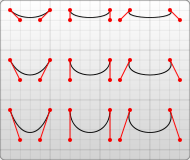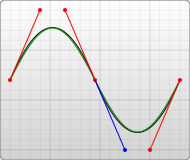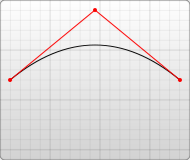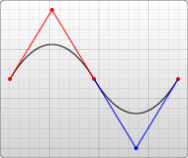Draw Part of Circle Svg
Paths
- « Previous
- Next »
The <path> element is the most powerful element in the SVG library of basic shapes. It tin be used to create lines, curves, arcs, and more.
Paths create complex shapes by combining multiple straight lines or curved lines. Complex shapes composed only of straight lines can exist created every bit <polyline>due south. While <polyline>s and <path>southward tin create like-looking shapes, <polyline>s crave a lot of pocket-sized directly lines to simulate curves, and don't scale well to larger sizes.
A skilful understanding of paths is important when drawing SVGs. While creating complex paths using an XML editor or text editor is not recommended, understanding how they piece of work will allow to identify and repair display issues in SVGs.
The shape of a <path> element is defined by one parameter: d. (See more in basic shapes.) The d attribute contains a series of commands and parameters used by those commands.
Each of the commands is instantiated (for example, creating a class, naming and locating it) by a specific letter. For instance, let'due south move to the 10 and y coordinates (x, 10). The "Move to" command is called with the alphabetic character Grand. When the parser runs into this letter, it knows it needs to move to a bespeak. And so, to motion to (10,10) the control to apply would be M x 10. After that, the parser begins reading for the next control.
All of the commands also come in 2 variants. An uppercase letter of the alphabet specifies accented coordinates on the folio, and a lowercase letter of the alphabet specifies relative coordinates (east.yard., motility 10px up and 7px to the left from the last signal).
Coordinates in the d parameter are ever unitless and hence in the user coordinate arrangement. Afterwards, nosotros will larn how paths can be transformed to adapt other needs.
Line commands
There are v line commands for <path> nodes. The kickoff command is the "Move To" or M, which was described in a higher place. Information technology takes two parameters, a coordinate (x) and coordinate (y) to movement to. If the cursor was already somewhere on the folio, no line is drawn to connect the two positions. The "Move To" command appears at the showtime of paths to specify where the drawing should commencement. For case:
In the following example at that place's but a signal at (10,10). Note, though, that it wouldn't show up if a path was just drawn normally. For case:

<svg width = "200" peak = "200" xmlns = "http://world wide web.w3.org/2000/svg" > <path d = "M10 10" /> <!-- Points --> <circle cx = "10" cy = "x" r = "2" fill = "cherry" /> </svg > At that place are three commands that draw lines. The well-nigh generic is the "Line To" command, called with 50. L takes two parameters—ten and y coordinates—and draws a line from the electric current position to a new position.
There are two abbreviated forms for drawing horizontal and vertical lines. H draws a horizontal line, and V draws a vertical line. Both commands merely accept i parameter since they only movement in 1 direction.
H ten (or) h dx Five y (or) five dy An easy identify to showtime is by cartoon a shape. Nosotros will start with a rectangle (the aforementioned blazon that could be more hands made with a <rect> chemical element). It'due south composed of horizontal and vertical lines only.

<svg width = "100" height = "100" xmlns = "http://www.w3.org/2000/svg" > <path d = "Thou 10 10 H 90 5 xc H 10 50 x ten" /> <!-- Points --> <circle cx = "x" cy = "ten" r = "2" fill up = "red" /> <circle cx = "90" cy = "xc" r = "two" fill = "carmine" /> <circle cx = "xc" cy = "ten" r = "2" fill = "red" /> <circle cx = "10" cy = "90" r = "ii" fill = "cerise" /> </svg > We can shorten the above path declaration a little bit by using the "Close Path" command, called with Z. This command draws a straight line from the electric current position back to the first point of the path. It is often placed at the cease of a path node, although not always. There is no difference between the uppercase and lowercase command.
Then our path higher up could exist shortened to:
<path d = "M x 10 H xc V ninety H 10 Z" fill = "transparent" stroke = "black" /> The relative forms of these commands can as well be used to depict the same picture. Relative commands are called by using lowercase messages, and rather than moving the cursor to an verbal coordinate, they move information technology relative to its last position. For instance, since our box is 80×80, the <path> element could have been written as:
<path d = "One thousand ten x h 80 v lxxx h -lxxx Z" fill up = "transparent" stroke = "blackness" /> The path will motion to point (10,10) and and then move horizontally 80 points to the right, then lxxx points downwards, and so lxxx points to the left, and so dorsum to the start.
In these examples, it would probably be simpler to use the <polygon> or <polyline> elements. However, paths are used so oftentimes in drawing SVG that developers may exist more comfortable using them instead. There is no existent performance penalisation or bonus for using 1 or the other.
Curve commands
At that place are iii dissimilar commands that tin can be used to create polish curves. Ii of those curves are Bézier curves, and the third is an "arc" or office of a circle. Y'all might have already gained applied experience with Bézier curves using path tools in Inkscape, Illustrator or Photoshop. There are an space number of Bézier curves, only only two simple ones are available in <path> elements: a cubic 1, called with C, and a quadratic ane, called with Q.
Bézier Curves
The cubic curve, C, is the slightly more complex curve. Cubic Béziers take in two control points for each point. Therefore, to create a cubic Bézier, 3 sets of coordinates need to exist specified.
C x1 y1, x2 y2, x y (or) c dx1 dy1, dx2 dy2, dx dy The final set of coordinates here (x,y) specify where the line should cease. The other ii are command points. (x1,y1) is the command point for the first of the curve, and (x2,y2) is the control bespeak for the end. The control points essentially draw the slope of the line starting at each indicate. The Bézier function then creates a shine curve that transfers from the gradient established at the beginning of the line, to the slope at the other finish.

<svg width = "190" height = "160" xmlns = "http://www.w3.org/2000/svg" > <path d = "Grand ten ten C 20 20, 40 twenty, fifty ten" stroke = "black" fill = "transparent" /> <path d = "M 70 10 C lxx 20, 110 20, 110 10" stroke = "black" fill = "transparent" /> <path d = "M 130 10 C 120 xx, 180 20, 170 x" stroke = "black" fill = "transparent" /> <path d = "Chiliad ten 60 C 20 80, forty lxxx, 50 60" stroke = "black" fill = "transparent" /> <path d = "Chiliad 70 60 C seventy 80, 110 fourscore, 110 lx" stroke = "black" fill = "transparent" /> <path d = "Thousand 130 sixty C 120 80, 180 80, 170 threescore" stroke = "black" fill = "transparent" /> <path d = "Thou 10 110 C xx 140, 40 140, 50 110" stroke = "black" fill = "transparent" /> <path d = "M lxx 110 C 70 140, 110 140, 110 110" stroke = "black" fill up = "transparent" /> <path d = "M 130 110 C 120 140, 180 140, 170 110" stroke = "blackness" fill up = "transparent" /> </svg > The example to a higher place creates nine cubic Bézier curves. As the curves movement toward the right, the control points become spread out horizontally. As the curves motion downwards, they become farther separated from the end points. The thing to note here is that the curve starts in the management of the starting time command betoken, so bends so that it arrives along the management of the second control indicate.
Several Bézier curves can be stringed together to create extended, smooth shapes. Ofttimes, the control point on i side of a point volition be a reflection of the control point used on the other side to keep the slope constant. In this case, a shortcut version of the cubic Bézier can be used, designated by the command S (or southward).
South x2 y2, x y (or) s dx2 dy2, dx dy Southward produces the same type of curve equally earlier—simply if information technology follows another S control or a C command, the first command point is assumed to be a reflection of the one used previously. If the Due south command doesn't follow another South or C control, then the current position of the cursor is used every bit the kickoff command point. In this case the result is the same as what the Q command would have produced with the same parameters.
An instance of this syntax is shown below, and in the effigy to the left the specified control points are shown in red, and the inferred command point in blueish.

<svg width = "190" height = "160" xmlns = "http://world wide web.w3.org/2000/svg" > <path d = "M 10 80 C 40 10, 65 x, 95 lxxx S 150 150, 180 lxxx" stroke = "black" fill = "transparent" /> </svg > The other type of Bézier curve, the quadratic curve chosen with Q, is actually a simpler curve than the cubic one. It requires 1 control signal which determines the slope of the bend at both the start point and the end point. It takes two parameters: the control point and the terminate indicate of the curve.
Notation: The co-ordinate deltas for q are both relative to the previous point (that is, dx and dy are not relative to dx1 and dy1).
Q x1 y1, x y (or) q dx1 dy1, dx dy 
<svg width = "190" height = "160" xmlns = "http://www.w3.org/2000/svg" > <path d = "M ten 80 Q 95 x 180 80" stroke = "black" fill = "transparent" /> </svg > As with the cubic Bézier curve, there is a shortcut for stringing together multiple quadratic Béziers, called with T.
This shortcut looks at the previous control bespeak used and infers a new one from it. This means that after the first control point, adequately complex shapes can be made by specifying merely stop points.
This simply works if the previous command was a Q or a T control. If non, then the control point is assumed to be the aforementioned every bit the previous point, and only lines volition be fatigued.

<svg width = "190" peak = "160" xmlns = "http://www.w3.org/2000/svg" > <path d = "1000 10 eighty Q 52.5 x, 95 80 T 180 fourscore" stroke = "black" fill = "transparent" /> </svg > Both curves produce similar results, although the cubic i allows greater freedom in exactly what the curve looks like. Deciding which bend to use is situational and depends on the corporeality of symmetry the line has.
Arcs
The other type of curved line that can exist created using SVG is the arc, called with the A control. Arcs are sections of circles or ellipses.
For a given ten-radius and y-radius, there are two ellipses that can connect whatever two points (as long as they're inside the radius of the circle). Forth either of those circles, at that place are two possible paths that can be taken to connect the points—so in any situation, there are iv possible arcs available.
Because of that, arcs require quite a few parameters:
A rx ry ten-axis-rotation large-arc-flag sweep-flag 10 y a rx ry x-axis-rotation big-arc-flag sweep-flag dx dy At its start, the arc element takes in 2 parameters for the x-radius and y-radius. If needed, come across <ellipse>s and how they behave. The final two parameters designate the ten and y coordinates to finish the stroke. Together, these four values define the basic construction of the arc.
The tertiary parameter describes the rotation of the arc. This is best explained with an example:

<svg width = "320" pinnacle = "320" xmlns = "http://www.w3.org/2000/svg" > <path d = "M 10 315 Fifty 110 215 A 30 50 0 0 1 162.55 162.45 Fifty 172.55 152.45 A 30 50 -45 0 1 215.1 109.9 Fifty 315 10" stroke = "black" fill = "green" stroke-width = "2" fill up-opacity = "0.5" /> </svg > The example shows a <path> element that goes diagonally across the page. At its center, 2 elliptical arcs have been cut out (x radius = 30, y radius = 50). In the starting time one, the x-axis-rotation has been left at 0, so the ellipse that the arc travels around (shown in gray) is oriented straight upwardly and down. For the second arc, though, the ten-centrality-rotation is set to -45 degrees. This rotates the ellipse so that it is aligned with its minor axis along the path direction, every bit shown by the second ellipse in the case image.
For the unrotated ellipse in the image higher up, there are only two different arcs and not four to choose from considering the line drawn from the first and terminate of the arc goes through the center of the ellipse. In a slightly modified example the two ellipses that grade the four different arcs can exist seen:

<svg xmlns = "http://www.w3.org/2000/svg" width = "320" height = "320" > <path d = "Yard 10 315 L 110 215 A 36 60 0 0 one 150.71 170.29 L 172.55 152.45 A xxx l -45 0 1 215.1 109.nine L 315 10" stroke = "black" fill = "greenish" stroke-width = "two" fill-opacity = "0.v" /> <circle cx = "150.71" cy = "170.29" r = "ii" fill up = "cerise" /> <circle cx = "110" cy = "215" r = "two" fill up = "cherry-red" /> <ellipse cx = "144.931" cy = "229.512" rx = "36" ry = "threescore" make full = "transparent" stroke = "blue" /> <ellipse cx = "115.779" cy = "155.778" rx = "36" ry = "60" fill = "transparent" stroke = "blueish" /> </svg > Discover that each of the blue ellipses are formed by ii arcs, depending on traveling clockwise or counter-clockwise. Each ellipse has one short arc and one long arc. The two ellipses are just mirror images of each other. They are flipped along the line formed from the start→end points.
If the start→stop points are further than the ellipse's x and y radius tin reach, the ellipse's radii will be minimally expanded so it could reach the first→cease points. The interactive codepen at the bottom of this page demonstrates this well. To make up one's mind if an ellipse's radii are large enough to crave expanding, a system of equations would need to be solved, such every bit this on wolfram alpha. This computation is for the non-rotated ellipse with start→finish (110, 215)→(150.71, 170.29). The solution, (ten, y), is the center of the ellipse(s). The solution will be imaginary if the ellipse'south radii are besides modest. This second computation is for the non-rotated ellipse with commencement→end (110, 215)→(162.55, 162.45). The solution has a pocket-sized imaginary component considering the ellipse was but barely expanded.
The four different paths mentioned higher up are determined by the adjacent two parameter flags. As mentioned earlier, there are nonetheless two possible ellipses for the path to travel around and 2 dissimilar possible paths on both ellipses, giving 4 possible paths. The first parameter is the large-arc-flag. Information technology determines if the arc should exist greater than or less than 180 degrees; in the end, this flag determines which direction the arc volition travel effectually a given circle. The second parameter is the sweep-flag. It determines if the arc should begin moving at positive angles or negative ones, which substantially picks which of the two circles volition be traveled around. The example below shows all 4 possible combinations, along with the two circles for each instance.

<svg width = "325" superlative = "325" xmlns = "http://world wide web.w3.org/2000/svg" > <path d = "K 80 80 A 45 45, 0, 0, 0, 125 125 50 125 80 Z" fill = "green" /> <path d = "Grand 230 lxxx A 45 45, 0, 1, 0, 275 125 L 275 80 Z" fill up = "red" /> <path d = "Thou 80 230 A 45 45, 0, 0, i, 125 275 L 125 230 Z" fill = "purple" /> <path d = "M 230 230 A 45 45, 0, 1, 1, 275 275 L 275 230 Z" fill up = "blue" /> </svg > Arcs are an easy mode to create pieces of circles or ellipses in drawings. For instance, a pie chart would require a dissimilar arc for each piece.
If transitioning to SVG from <canvas>, arcs can exist the hardest thing to larn, but are also much more powerful. Complete circles and ellipses are the simply shapes that SVG arcs take trouble drawing. Because the commencement and end points for any path going effectually a circle are the same betoken, there are an space number of circles that could exist chosen, and the actual path is undefined. It'south possible to approximate them past making the start and end points of the path slightly askew, and then connecting them with another path segment. For example, it's possible to make a circle with an arc for each semi-circle. At that point, information technology's often easier to use a real <circumvolve> or <ellipse> node instead. This interactive demo might help understand the concepts backside SVG arcs: https://codepen.io/lingtalfi/pen/yaLWJG (tested in chrome and firefox only, might not work in your browser)
- « Previous
- Next »
Source: https://developer.mozilla.org/en-US/docs/Web/SVG/Tutorial/Paths
0 Response to "Draw Part of Circle Svg"
Post a Comment